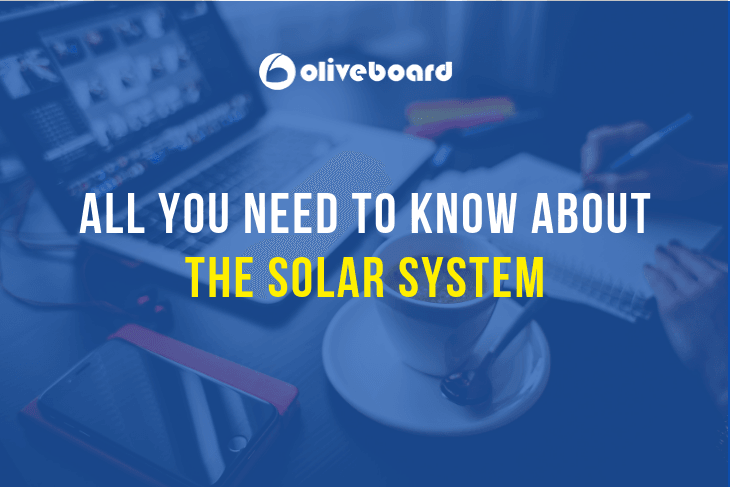You must have read about the solar system when you were in school, but it is also important to know about the solar system if you are planning on sitting for any competitive entrance examinations such as IBPS PO, IBPS Clerk, SBI Clerk SBI PO, SSC CGL, SSC CPO, and Railways RRB. You will come across questions related to this in your SBI PO test series. Read on to know more about the solar system.
About the Solar System
The solar system consists of eight planets and their dwarf planets, asteroids, satellites, comets, and meteors. Apart from the eight planets, the Sun is also a part of the solar system. The Sun always stays in the centre of the solar system and all the planet revolve around it, also known as elliptical orbits. Listed below are some facts about the Sun and the other eight planets.
- The Sun
The Sun is situated really close to the Earth, because of which it is the closest star to it. It is made of 25% helium and 73% hydrogen and the core temperature is a whopping 15 million degree Celsius.
- Mercury
Mercury is located closest to the Sun and has no notable atmosphere. It orbits the Sun the swiftest, but its rotation duration is longer than its revolution period. You can see Mercury from earth only after sunset and before sunrise. Additionally, it has no natural satellites or moons.
- Venus
Venus has the longest rotational duration amongst all the planets, and it is referred to as earth’s twin. Unlike other planets that revolve around the Sun in an anti-clockwise manner, Venus does in the clockwise direction. Additionally, it is also the brightest natural object in the sky at night, after the Moon.
- Earth
The earth is the only planet in the solar system that has the presence of human life and has water in all three states- solid, liquid and gas. It takes earth 23 hours 56 minutes 46 seconds to complete its rotation and 365 days to complete its revolution around the Sun. The Moon is the natural satellite of earth and the gases present in the Earth’s atmosphere are Carbon Dioxide, Oxygen, Hydrogen, Nitrogen etc.
- Mars
Mars is also known as the Red planet due to its distinctive red colour. Its red colour is caused by the presence of the iron-rich soil. It has two moons known as Deimos and Phobos and has the largest known volcano in the solar system. Recently, evidence of sub-terrestrial liquid water and polar ice caps has been found on Mars.
- Jupiter
Jupiter is the largest planet in the solar system and has the shortest rotational period. It has around two and a half times of extra mass and boasts of 67 moons. It is mainly made of gases like helium and hydrogen and has no noticeable solid surface.
- Saturn
Saturn is the second largest planet in the solar system after Jupiter and has 62 moons. Its largest moon is named Titan. Apart from Titan, it has two more moons known as Rhea and Enceladus. The rings of Saturn are made of numerous small particles, almost entirely consisting of water ice and traces of rocky materials.
- Uranus
Uranus is the third largest planet in the solar system, after Jupiter and Saturn and is cyan in colour. It has 27 identified moons out of which the five main moons are Oberon, Titania, Umbriel, Ariel, and Miranda. Uranus also has very faint rings and is made of Methane, Hydrogen, Ammonia, Water, and Helium.
- Neptune
Neptune is located the farthest away from the Sun and is classified as blue in colour due to the presence of methane. It has 14 moons, with Triton being the biggest and has a giant storm system, as big as the size of the Earth, called the ‘Great Dark Spot’. Neptune is mostly composed of gases like Helium, Water, Methane, Ammonia, Hydrogen, and Nitrogen.
- Pluto
Previously, Pluto was considered as the ninth planet, but as of now, it is not counted as one of the solar system planets. It has been reduced to a dwarf planet. It consists of five moons known as Hydra, Kerberos, Nix, Styx, and Charon. Pluto has a very cold and icy atmosphere.
Apart from the eight planets and the Sun, the solar system consists of minor planets, stars, asteroids, and the galaxy. You will get more detailed information in textbooks, which are very important for the preparation of competitive exams.
Having a good idea about the solar system and its planets will help you a great deal when it comes to your general knowledge and your competitive recruitment exams. When you will be preparing for your exams, you might encounter questions on this topic in your SBI PO practice set.

The most comprehensive online preparation portal for MBA, Banking and Government exams. Explore a range of mock tests and study material at www.oliveboard.in

